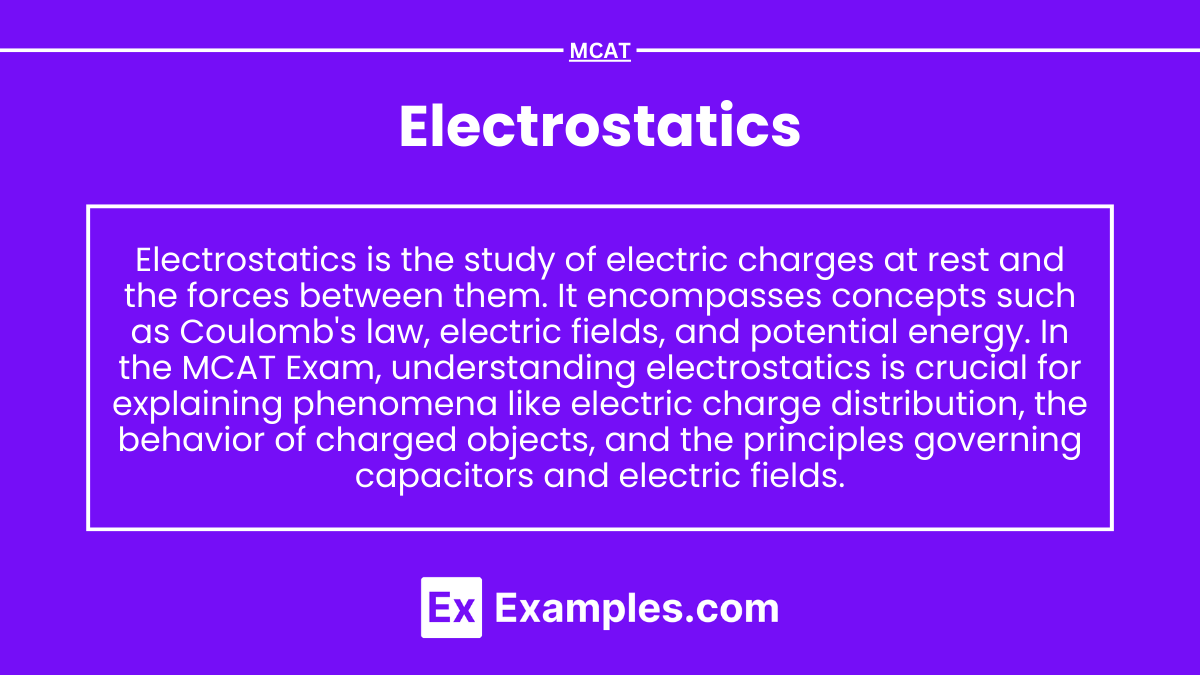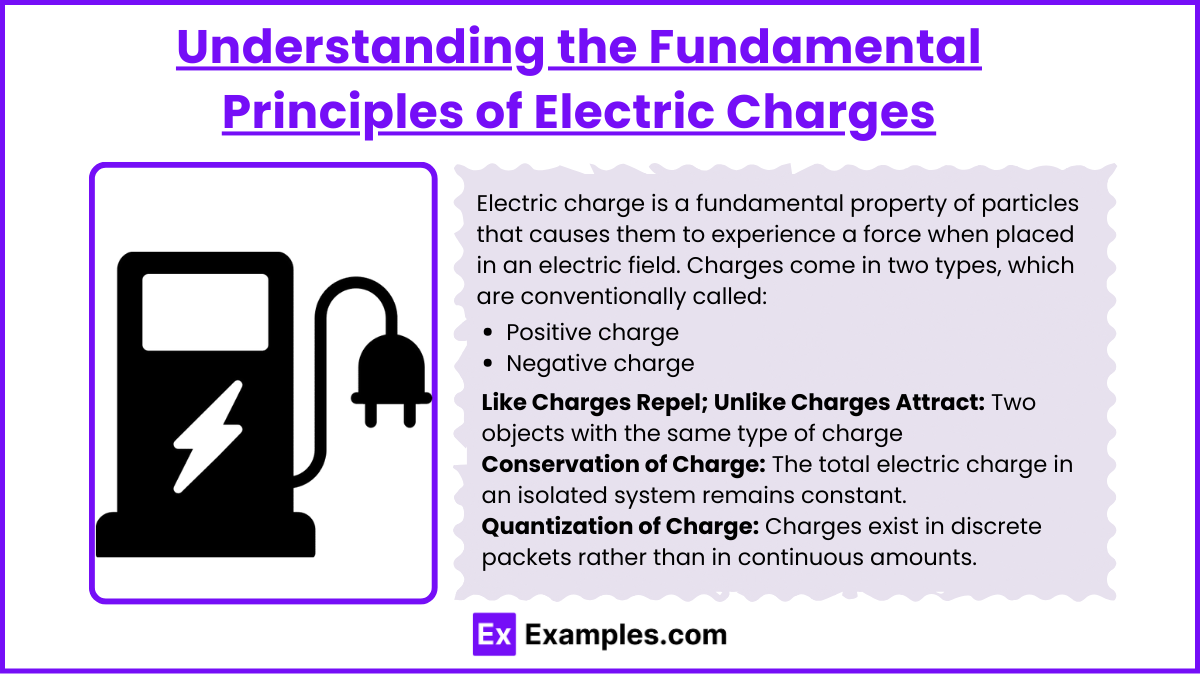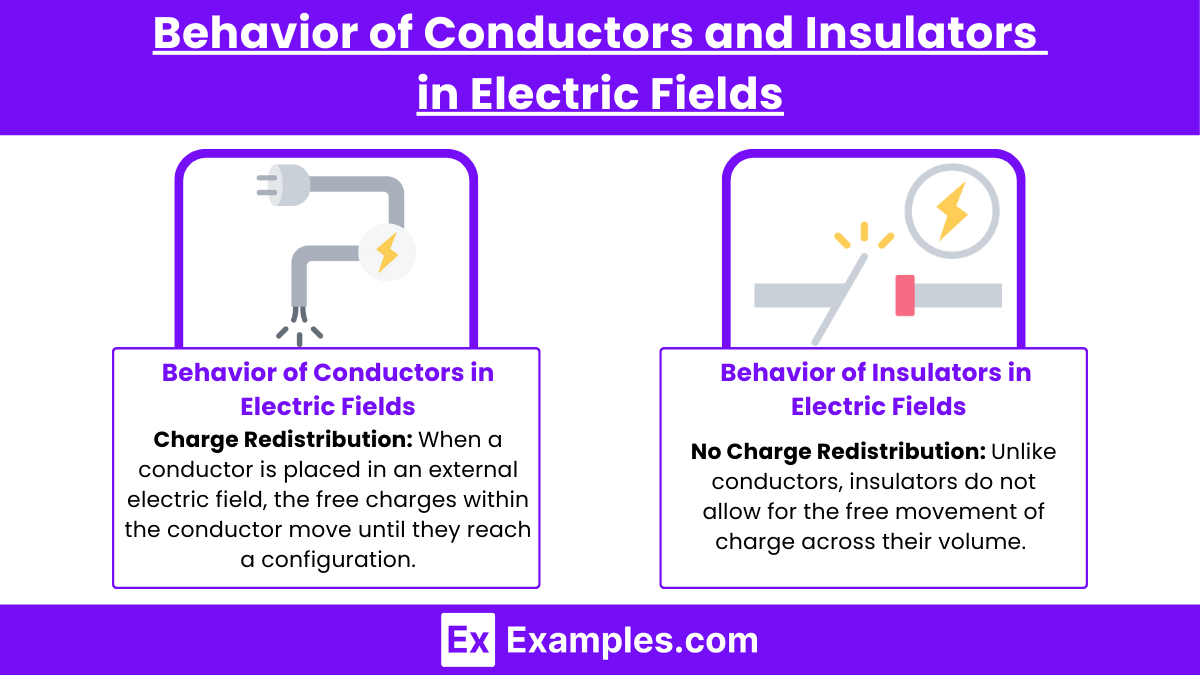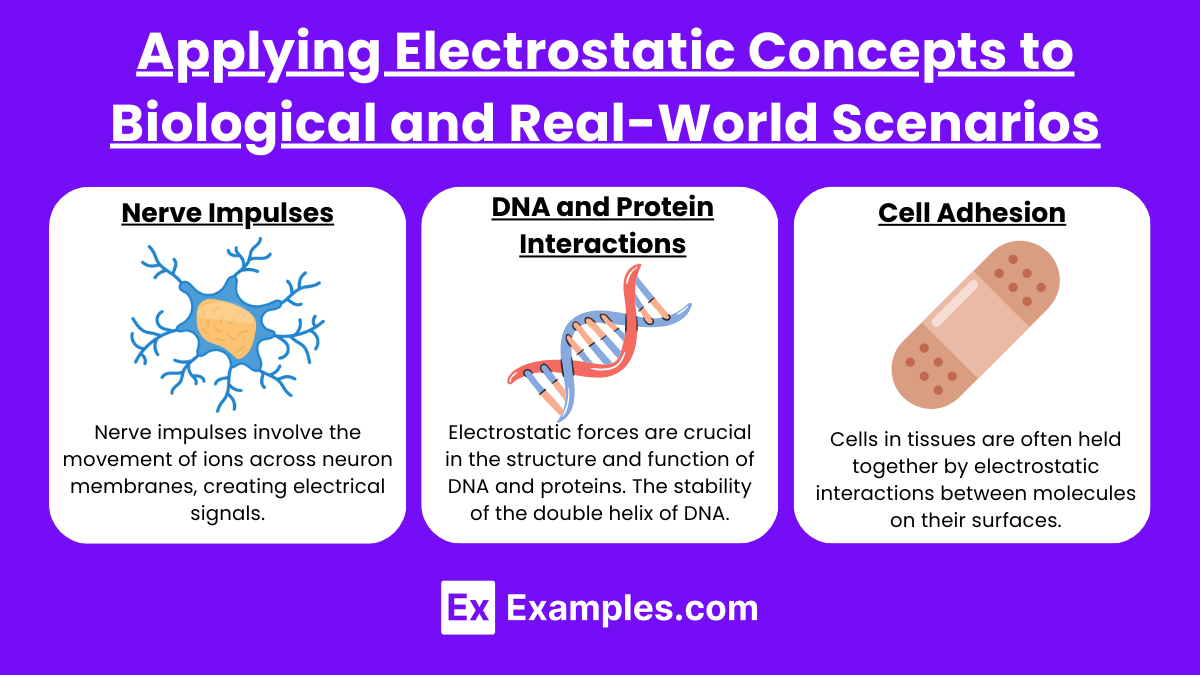Electrostatics is a fundamental topic in physics, dealing with the study of electric charges at rest. On the MCAT, you’ll explore the behavior of charged particles, Coulomb's law, and the concept of electric fields and potentials. Understanding how charges interact, the principles of electric force, and energy in electric systems is essential, as these concepts are crucial for mastering both physics and physical chemistry sections of the exam.
Learning Objectives
In studying "Electrostatics" for the MCAT, you should learn to understand the fundamental principles governing electric charges, including the properties of like and unlike charges and their interactions. Analyze Coulomb’s law to calculate the force between two point charges. Understand electric fields, their representation through field lines, and how they influence charged particles. Study the concept of electric potential, potential energy, and equipotential surfaces, and how these relate to work and energy conservation. Evaluate the behavior of conductors and insulators in electric fields, including charge distribution. Additionally, develop problem-solving skills by applying electrostatic concepts to biological and real-world scenarios, such as nerve impulses and electrophoresis.
Understanding the Fundamental Principles of Electric Charges
Nature of Electric Charges
Electric charge is a fundamental property of particles that causes them to experience a force when placed in an electric field. Charges come in two types, which are conventionally called:
Positive charge
Negative charge
Key Principles:
Like Charges Repel; Unlike Charges Attract: Two objects with the same type of charge repel each other, while objects with opposite charges attract each other. This fundamental principle of electrostatics is quantified by Coulomb's Law.
Conservation of Charge: The total electric charge in an isolated system remains constant. This means that charge can neither be created nor destroyed, only transferred from one body to another.
Quantization of Charge: Charges exist in discrete packets rather than in continuous amounts. The smallest unit of charge is the charge of one electron or proton, often denoted by eee (approximately 1.602×10−19 coulombs). All observable charges are integer multiples of this elementary charge.
Coulomb's Law
Coulomb's Law quantitatively describes the force between two point charges. It states that the magnitude of the electrostatic force between two point charges is directly proportional to the product of the magnitudes of the charges and inversely proportional to the square of the distance between them: F = k∣q1q2∣/r2
where:
F is the magnitude of the electrostatic force between the two charges,
q1 and q2 are the amounts of the charges,
r is the distance between the charges,
k is Coulomb's constant (= 8.987×109 Nm2/C2).
Conductors and Insulators
Conductors: Materials that allow electric charges to move freely through them. Metals are typical conductors because they contain free electrons that can move easily throughout the material.
Insulators: Materials that do not allow charges to move freely. Most non-metallic solids are insulators, as their electrons are tightly bound to their atoms and cannot move freely.
Electric Field Concept
An electric field describes the electric force per unit charge at a point in space. It is a vector field that points in the direction a positive test charge would move if placed in the field. The strength of the electric field created by a point charge q is given by: E = k∣q∣/r2 where:
E is the electric field strength,
r is the distance from the charge generating the field.
Behavior of Conductors and Insulators in Electric Fields
Behavior of Conductors in Electric Fields
Conductors, such as metals, contain free charge carriers (usually electrons) that can move relatively freely within the material. Here's how they behave in electric fields:
Charge Redistribution: When a conductor is placed in an external electric field, the free charges within the conductor move until they reach a configuration where the internal electric field created by the redistribution of these charges exactly cancels the external electric field within the conductor. This results in the electric field inside the conductor being zero.
Surface Charges: Since the internal electric field is zero, any excess charge on a conductor will reside on its surface. The distribution of this surface charge will adjust itself to ensure that the field inside remains zero.
Equipotential Nature: A conductor in electrostatic equilibrium is an equipotential surface. This means that the electric potential is constant throughout its volume and on its surface. No voltage difference can exist within the conductor, which implies no electric field within the conductor.
Shielding Effect: Conductors can shield the interior from external electric fields, a phenomenon used in Faraday cages. These enclosures block external static and non-static electric fields by channeling electricity along and around, but not through, the conducting material.
Behavior of Insulators in Electric Fields
Insulators, or dielectrics, do not have free charge carriers. Their electrons are tightly bound to their atoms or molecules, and do not move freely through the material. Here’s how insulators behave in electric fields:
No Charge Redistribution: Unlike conductors, insulators do not allow for the free movement of charge across their volume. When subjected to an electric field, the charges within an insulator do not redistribute significantly.
Polarization: Although the charges in an insulator do not flow, they can slightly shift from their average positions. This shifting, or polarization, involves aligning the small, induced dipoles in the material with the external electric field. This effect results in a slight internal electric field in the opposite direction to the external field, partially offsetting it but not canceling it out completely.
Electric Field Penetration: Since insulators do not redistribute charge to cancel the external electric field, the field penetrates through the material. This penetration can induce stress within the insulator, particularly at high field strengths, potentially leading to electrical breakdown if the field strength exceeds the material's dielectric strength.
Applying Electrostatic Concepts to Biological and Real-World Scenarios
Electrostatics in Biological Systems
1. Nerve Impulses:
Nerve impulses involve the movement of ions across neuron membranes, creating electrical signals. This process is governed by electrostatic and chemical gradients across the cell membrane, where different concentrations of ions on either side of the membrane create a voltage difference known as the resting membrane potential.
Understanding this helps in fields such as neurology and pharmacology, particularly in designing drugs that affect nerve transmission.
2. DNA and Protein Interactions:
Electrostatic forces are crucial in the structure and function of DNA and proteins. The stability of the double helix of DNA, for instance, is partly maintained by the electrostatic attractions between the negatively charged phosphate groups and the positively charged proteins in the nucleus.
This knowledge is essential in genetic engineering, molecular biology, and biotechnology.
3. Cell Adhesion:
Cells in tissues are often held together by electrostatic interactions between molecules on their surfaces. These interactions are also vital in cell communication and signaling.
Insights into cell adhesion are critical for developing medical implants and understanding cancer metastasis.
Electrostatics in Real-World Scenarios
1. Electrostatic Discharge (ESD): ESD occurs when there is a sudden flow of electricity between two electrically charged objects caused by contact, an electrical short, or dielectric breakdown. This is commonly experienced when touching a doorknob after walking across a carpeted floor. Managing ESD is critical in electronics manufacturing, where it can damage sensitive electronic components. Industries use grounding bracelets, anti-static mats, and humidity control to mitigate ESD risks.
2. Pollution Control: Electrostatic precipitators are used to remove particles from exhaust gases in power plants and factories before they are released into the atmosphere. They work by charging particles electrostatically and then collecting them on oppositely charged surfaces.This technology is vital for air quality control and is used to meet environmental regulations regarding particulate emissions.
3. Imaging and Printing Technologies: Photocopiers and laser printers use electrostatic charges to transfer ink or toner onto paper. The image or text to be copied is first created as an electrostatic image on a drum, attracting toner particles that are then transferred and fixed onto paper. The efficiency and quality of photocopying and printing technologies depend significantly on the precise application and control of electrostatic charges.
4. Painting and Coating Technologies: Electrostatic painting involves charging paint particles as they pass through a sprayer, causing them to be attracted to the target surface, which is oppositely charged or grounded. This results in a uniform and efficient coating. This method is widely used in the automotive and manufacturing industries to achieve high-quality finishes with reduced waste.
Examples
Example 1: Static Electricity on Clothes
When you remove a sweater, especially in dry conditions, you may notice that the sweater clings to your body or that small sparks can occur. This is due to static electricity caused by the transfer of electrons between the fabric and your skin. The friction between the sweater and your clothing can lead to an imbalance of charge, resulting in the sweater becoming positively or negatively charged, which creates the electrostatic attraction that causes the clinging effect.
Example 2: Static Electricity on Clothes
An electroscope is a simple device used to detect electric charge. It consists of a metal rod connected to two thin metal leaves. When a charged object is brought near the electroscope, electrons may be transferred, causing the leaves to either repel each other if they acquire the same charge or attract if they acquire opposite charges. This behavior demonstrates the principles of electrostatics and allows us to visualize electric charge.
Example 3: Static Electricity on Clothes
A Van de Graaff generator is a device that generates high voltages through the process of electrostatic induction. As the metal sphere accumulates electric charge, it can create a significant potential difference. When a person touches the sphere, they can receive a shock due to the sudden discharge of electricity. This example illustrates how electrostatics can be harnessed to generate and transfer electric charges in a controlled manner.
Example 4: Static Electricity on Clothes
Lightning is a natural example of electrostatics at work. During a thunderstorm, clouds accumulate electric charges due to the movement of water droplets and ice particles. The separation of positive and negative charges within the clouds creates a strong electric field. When this field becomes intense enough, it overcomes the insulating properties of air, resulting in a rapid discharge of electricity in the form of a lightning bolt. This phenomenon showcases the power of electrostatics in nature.
Example 5: Static Electricity on Clothes
Charging by induction is a method used to charge an object without direct contact. For instance, if a negatively charged rod is brought near a neutral metal sphere, it will induce a separation of charges within the sphere. The side closest to the rod will become positively charged, while the far side becomes negatively charged. If the sphere is grounded (connected to the earth), electrons will flow away, leaving the sphere positively charged. This process demonstrates the principles of electrostatics and charge distribution.
Practice Questions
Question 1
Which of the following statements best describes electrostatic charge?
A) It can be created or destroyed.
B) It is only produced by rubbing materials together.
C) Like charges repel each other, while opposite charges attract.
D) It is always negative in nature.
Correct Answer: C) Like charges repel each other, while opposite charges attract.
Explanation: Electrostatic charge is a fundamental property of matter. Like charges (positive and positive or negative and negative) repel each other, while opposite charges (positive and negative) attract each other. This principle is foundational to understanding electrostatics. Option A is incorrect because charge cannot be created or destroyed; it can only be transferred. Option B is misleading, as electrostatic charge can also arise from other processes, such as induction. Option D is false, as both positive and negative charges exist.
Question 2
What is the purpose of an electroscope?
A) To measure current flow in a circuit.
B) To detect the presence of electric charge.
C) To generate static electricity.
D) To convert electrical energy to mechanical energy.
Correct Answer: B) To detect the presence of electric charge.
Explanation: An electroscope is a device used to detect electric charge. It typically consists of a metal rod with leaves that diverge when charged. When a charged object comes close to the electroscope, it induces a charge that causes the leaves to repel each other, indicating the presence of an electric charge. Option A refers to an ammeter, not an electroscope. Option C is incorrect because an electroscope does not generate electricity; it simply detects charge. Option D describes a generator, which is unrelated to the function of an electroscope.
Question 3
In charging by induction, what happens to a neutral conductor when a charged object is brought near it?
A) The conductor gains a net charge of the same type as the object.
B) The conductor remains neutral with no change in charge.
C) The charges within the conductor redistribute, creating a temporary charge separation.
D) The conductor loses its electrons to the charged object.
Correct Answer: C) The charges within the conductor redistribute, creating a temporary charge separation.
Explanation: When a charged object is brought near a neutral conductor, the electric field of the charged object causes the charges within the conductor to rearrange. This redistribution leads to one side of the conductor becoming positively charged and the other side becoming negatively charged, creating a temporary charge separation. Option A is incorrect because the overall charge of the conductor does not change unless it is grounded. Option B is false, as there is a temporary redistribution of charge. Option D is misleading, as the conductor does not lose electrons unless it is grounded.





